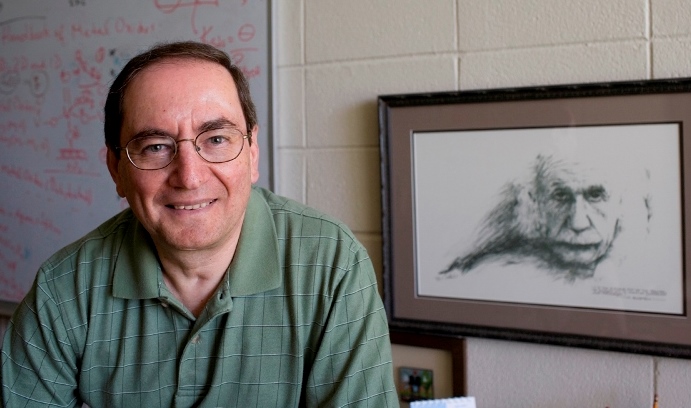Taking aim at acid gases

Israel E. Wachs, director of the Operando Molecular Spectroscopy and Catalysis Research Lab, is Lehigh's lead researcher in a new multi-institution research center that is funded by the U.S. Department of Energy and dedicated to controlling acid gases.
A coalition that includes Lehigh, five other research universities and Oak Ridge National Laboratories has received an $11.2 million grant to streamline the removal of carbon dioxide and other acid gases from large-scale energy applications.
The four-year award from the U.S. Department of Energy (DOE) will be shared by the Georgia Institute of Technology, Washington University in St. Louis and the Universities of Alabama, Florida and Wisconsin, as well as Lehigh and Oak Ridge.
The institutions have formed an Energy Frontier Research Center (EFRC) for Understanding and Control of Acid Gas-induced Evolution of Materials for Energy (UNCAGE-ME).
Georgia Tech is the lead university for the project. Israel E. Wachs, the G. Whitney Snyder Professor of Chemical and Biomolecular Engineering, is the lead researcher for Lehigh and one of 17 co-principal investigators from the seven institutions.
“I find this to be an amazingly exciting opportunity,” said Wachs, who is director of Lehigh’s Operando Molecular Spectroscopy and Catalysis Research Lab. “This is an extremely impressive collection of researchers from institutions with leading-edge instrumentation and theoretical capabilities.
“I’ve never seen this kind of enthusiasm for collaborating on a project and moving forward with new technologies.”
A lineup of noxious compounds
Acid gases, including carbon dioxide (CO2), sulfur oxides (SOx), nitrogen oxides (NOx) and hydrogen sulfide (H2S), are generated by automobiles, fossil-fuel power plants, natural gas extraction, refineries, industrial processes, chemical manufacturing and other activities. Acid gases harm people, trees and crops. Also, CO2 and NOx are global warming or greenhouse gases.
Scientists use membranes and sorbents to separate and concentrate CO2 for storage (carbon sequestration). Reactive catalysts convert acid gases to less harmful compounds—solid carbonates, solid sulfates and gaseous nitrogen (N2)—and for the manufacture of basic chemicals such as methanol and sulfuric acid as well as carbon sequestration. The performance and durability of membranes, sorbents and catalysts, however, can be undermined by the corrosive and degrading effects of the acid gases.
The EFRC researchers hope to gain a better understanding of how acid gases interact with membranes, sorbents and catalysts that will allow them to predict or prolong the lifetimes of these agents.
“There have been no systematic, fundamental studies of how acid gases affect catalysts, sorbents or membranes,” said Wachs.
Wachs and the other researchers will perform molecular spectroscopic studies of the surface functionalities and bulk structures of membranes, sorbents and catalysts. They will combine these studies with multiscale computational and theoretical modeling of acid gas interactions with solid membranes, sorbents and catalysts.
“An army of collaborators”
The group is dividing its studies into four thrust areas—the interaction of acid gases with nonporous oxide-based solids, the effect of defects and dopants on acid gas interactions with ordered porous materials, the interaction of acid gases with disordered porous solids, and the interaction of acid gases with the external surfaces of porous materials.
Wachs, a leader in the first and third thrusts, is renowned for his use of molecular spectroscopy to study the surfaces of heterogeneous catalysts under processing conditions and for exploring the relationship between catalysts’ structure and their activity for applications such as photocatalysis, environmental catalysis, fuels and chemicals.
“Supported amines, carbide-derived carbons and other disordered porous materials attract acid gases,” said Wachs. “We want these materials to have long-term sustainability and not to be poisoned by the acids.
“We want to look at the interaction of acid gases with interior pores as well as with the surfaces of porous materials, and to learn to make 2D oxides, nanoporous materials and metal organic frameworks [MOFs]. Very little work has been done in this area.”
A benefit of the new research center, said Wachs, is that it will give researchers at member institutions access to each other’s instrumentation, theoretical capabilities and research expertise. This could help him solve problems he has worked on for much of his career.
“If I put vanadium on a titanium dioxide support for the conversion of NOx to nitrogen, I want to know at what temperature the vanadium starts to move and how fast on the surface the vanadium molecules are dispersing.
“I have thought about this for 25 years. Now I have access to modern instrumentation to check this out experimentally.
“This new research center gives us an army of people to collaborate with. It’s just a fantastic and exciting opportunity.”
Wachs has published more than 300 technical articles in his career, and he holds more than three dozen patents. His numerous awards include the 2002 Clean Air Excellence award from the U.S. Environmental Protection Agency, the George A. Olah Award from the American Chemical Society (ACS), and the Catalysis and Reaction Engineering Division Practice Award from the American Institute of Chemical Engineering (AIChE).
In 2011, Wachs was named a Fellow of the ACS. The following year, he received the Humboldt Research Award for senior scientists from Germany’s Alexander von Humbolt Foundation and the Vanadis Award from the International Vanadium Chemistry Organization.
Story by Kurt Pfitzer
Photo by Theo Anderson
Posted on:

